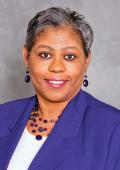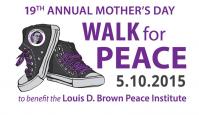May 6, 2015
 Tina CheryLed by Boston Medical Center, major teaching hospitals in Boston are adopting the Survivor’s Burial and Resource Guide created by Tina Chery, president and CEO of the Louis D. Brown Peace Institute in Fields Corner. Social workers say the book gives families a powerful new tool for dealing with the stresses they face after a loved one is murdered.
Tina CheryLed by Boston Medical Center, major teaching hospitals in Boston are adopting the Survivor’s Burial and Resource Guide created by Tina Chery, president and CEO of the Louis D. Brown Peace Institute in Fields Corner. Social workers say the book gives families a powerful new tool for dealing with the stresses they face after a loved one is murdered.
“In the aftermath of homicide, family members can be quickly overwhelmed by practical issues,” said Amanda Wright, social work supervisor at BMC. Police detectives may want to talk to them. They have to call relatives, notify employers, pick up children from school. Their loved one’s body and all clothing will be taken to the Medical Examiner’s office. The family will have to contact that office later to find out when a funeral can be scheduled.
 Guide to this Sunday's Mother's Walk for Peace: Download a special supplement to this week's Dorchester Reporter“It’s daunting,” said Wright.
Guide to this Sunday's Mother's Walk for Peace: Download a special supplement to this week's Dorchester Reporter“It’s daunting,” said Wright.
At BMC, social workers are on staff 24/7 in the emergency department to assist victims of trauma and their families. After watching distraught relatives stuff business cards into a pocket or search for a piece of paper on which to write important phone numbers, Wright and her colleagues knew they needed a more effective way to provide information. Chery’s guide helps manage the chaos.
“At a time when you can barely function, there is suddenly so much to do,” writes Chery, who founded the Peace Institute after her 15-year old son Louis was murdered in 1993. The Institute offers emotional support and practical advice to families impacted by homicide. The guide is based on Chery’s experience and that of the many families the Institute has helped.
“Before you even leave the hospital, you need to know how to contact the Medical Examiner and the District Attorney’s Office,” said Chery in a recent interview. “A lot of times, you get home and the media are already there ahead of you.”
It’s the sort of thing only another survivor would know, said Wright. And only another survivor would know to format the guide as a workbook, with space for users to keep track of important contacts as they go along. The first section includes space to write in contact information for the EMTs, doctors, nurses and social workers at the hospital.
“Often families want to reach out to the medical team later to learn more about their loved one’s last hours,” said Wright. The book outlines tasks simply and clearly. Just paging through the first section, families can see what they have to do.
“The most important thing is, it gives them the next steps,” said Wright.
Emma Riley, social work manager at BMC, said that people in crisis often have trouble absorbing information. So Riley goes over the next steps and gives families their own copy of the guide. They don’t need to remember details or take notes. The guide has the information they will need to navigate the social service and criminal justice systems. “That gives us a chance to talk to them about how they are feeling in the moment,” said Riley.
Families have also told Riley that when they arrived home, friends were there to offer help. Do you want me to handle this? Do you want me to handle that? “They could just hand the guide to that person and it had all the information about what to do,” said Riley.
There are dozens of tasks. Someone has to notify friends and employers of the death. Someone has to write a statement for the media. Someone has to take care of children, answer the phone, compose an obituary. Chery has organized all of it into specific areas. She recommends assigning a go-to person for each area who can delegate the work and make sure everything is taken care of.
“That way you don’t have to handle everything yourself,” said Chery. “ Forming a team also helps you feel less alone.”
Arranging the funeral is the toughest job. How much does a funeral cost? Where will we get the money? According to Chery, a state program for victims of violent crime currently provides up to $8,000 for funeral expenses when families do not have insurance or other resources.
“Just make sure that the funeral home will accept Victim’s Compensation as a form of payment,” said Chery. “And prices vary a lot, so get at least three quotes before authorizing the Medical Examiner to release the body to the funeral home.”
Chery’s clear, uncomplicated approach makes it all doable. “I wish we had a similar guide for families that lose loved ones from other causes,” said Wright.
Boston Medical Center now refers surviving families to the Peace Institute itself, where they can get practical help from people who have been through the same experience. The Institute also offers programs for long-term healing, including programs for children. Several survivors have written personal accounts that Chery includes in the book.
The guide gives step-by-step instructions for finding a mental health provider. Initially, survivors may not think they need mental health services, Riley said. But in a few weeks or months that can change. Difficulty sleeping and anxiety can worsen. Children can gradually develop problems at school that make parents want to reach out for professional help.
Homicide is traumatic to survivors in a way that other bereavement – even other trauma – is not, the social workers said.
“Any time there is a violent crime, we see people who become what we call hypervigilant – continually fearful and on guard,” Riley said. Because survivors do not know who has done the killing, or why it has happened, they fear for their own safety. That the violence was done intentionally is deeply disturbing. As one survivor wrote in the guide: The horror and shock… made it harder than any other passing in our family.
Grief evolves differently after a homicide, said Cynthia Kennedy, clinical coordinator for homicide support services at Beth Israel Deaconess Medical Center. A counselor from that hospital has worked part-time at the Peace Institute for several years. Kennedy said that after a loved one is murdered, deep longing for that person often coexists with PTSD. Self-recrimination is common, especially among parents. They can torment themselves thinking: If only I had done this or that, my child would not have been in the wrong place at the wrong time.
Survivors often believe they will feel better when the killer is put on trial and sent to prison. “But that can take years,” Kennedy said. “Meanwhile your life is on hold.” The guide attests to this with pages of phone numbers and logs for recording contacts with law enforcement agencies.
Chery devotes another section to dealing with the media. Media coverage can intensify the pain, according to survivor Marisa Coleman. Her family experienced this after the murder of her 18-year-old brother, Herman Taylor III.
As Coleman writes: “My brother’s death received a significant amount of media coverage. We were disappointed in the way his death was portrayed in the newspapers and we wanted to humanize his life by writing a family statement to share with the media and his communities. It proved to work in our favor, as it turned a family tragedy into love and a call for peace.”
Coleman’s family also used tools in the guide to write an obituary and arrange her brother’s funeral service.
“His “going home” service was one of the most powerful experiences of my life. Every detail, every moment spoke to his life and to the many lives he touched,” writes Coleman.
“Survivors are really the ones who know what information other survivors need,” said Mardi Chadwick, director of violence prevention and recovery programs at Brigham and Women’s Hospital. Since Brigham and Women’s introduced the guide several months ago, Chadwick has seen the difference it can make.
“Chery’s guide gives people some control at probably the worst time in their lives,” she said. Like Wright, Chadwick has been thinking about creating something similar for other kinds of patients.
“But anything we do will be survivor-led,” she said.
Chadwick oversees programs in sexual assault, domestic violence, community violence and human trafficking. She said that victim advocates can spend hours helping crime victims deal with insurance, disability and other bureaucratic issues. “The system is really hard to navigate,” Chadwick said. That leaves less time to offer psychological support, what she calls “the human conversation.” By contrast, Chery’s guide condenses all the necessary information into a tool that families can take with them.
Wright puts it this way: “After you lose a loved one to homicide, the medical examiner takes his body, his clothing, his cell phone, his wallet. You walk out of the hospital with nothing – only now you have the guide.”
Topics:


